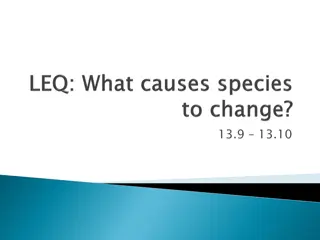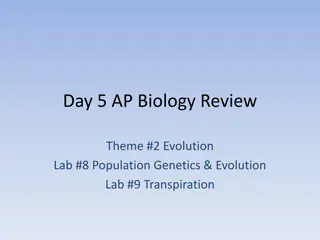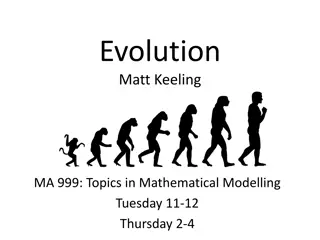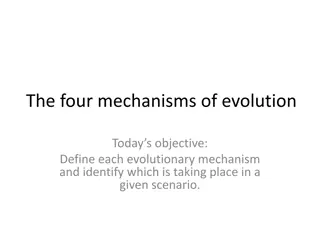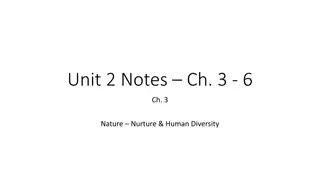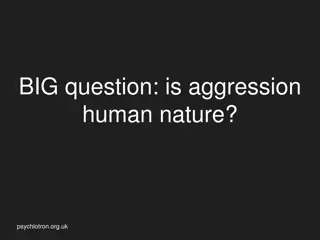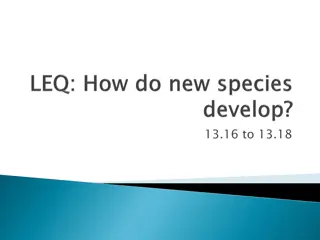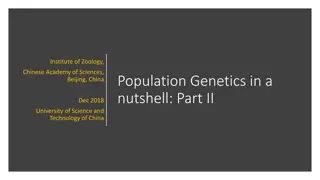Evolutionary Insights: AP Biology Review on Population Genetics and Natural Selection
Explore themes of evolution, population genetics, and natural selection in AP Biology, delving into concepts like Hardy-Weinberg equilibrium, allele frequencies, and the impact of natural selection on introduced species. Understand how molecular and cellular events lead to emergent properties at individual and population levels. Dive into case studies to analyze genetic outcomes under different scenarios.
Download Presentation

Please find below an Image/Link to download the presentation.
The content on the website is provided AS IS for your information and personal use only. It may not be sold, licensed, or shared on other websites without obtaining consent from the author. Download presentation by click this link. If you encounter any issues during the download, it is possible that the publisher has removed the file from their server.
E N D
Presentation Transcript
Day 5 AP Biology Review Theme #2 Evolution Lab #8 Population Genetics & Evolution Lab #9 Transpiration
EvolutionEvolution is the biological change of organisms that occurs over time and is driven by the process of natural selection. Evolution accounts for the diversity of life on Earth. Example: Widespread use of antibiotics has selected for antibiotic resistance in disease- causing bacteria. Evolution - Students will compare ecological time with evolutionary time and examine how they correspond.
Theme #2 Evolution Heterozygotes at the sickle-cell locus produce both normal and abnormal (sickle cell) hemoglobin. When hemoglobin molecules are packed into a heterozygote s red blood cells, some cells receive relatively large quantities of abnormal hemoglobin, making these cells prone to sickling. In a short essay (100 150 words), explain how these molecular and cellular events lead to emergent properties at the individual and population level of biological organization.
One factor favoring rapid population growth by an introduced species is the absence of the predators, parasites, and pathogens that controlled its population in the region where it evolved. In a short essay (100 150 words), explain how evolution by natural selection would influence the rate at which native predators, parasites, and pathogens in a region of introduction attack an introduced species.
Lab #8 Population Genetics & Evolution Hardy Weinberg Equilibrium Allele Frequencies: p(B) + q(b) = 1 Genotypic Frequencies: BB + Bb + bb = 1 Frequency of the possible diploid combinations of alleles p2+2pq +q2= 1 Tasters vs. Nontasters
Five Conditions in the populations allele & genotype frequencies will remain constant from generation to generation. 1. The breeding population is large. Why? 2. Mating is random. Why? 3. There is no mutation of the alleles. Why? 4. No differential migration occurs. Why? 5. There is no selection. Why? So What? It provides a yardstick by which changes in allele frequency and evolution can be measured.
Case Studies Case #1 Ideal Hardy Weinberg: AA = .25 .25 Aa = .5 .5 aa = .25 .25 Case #2 Selection: AA = .25 .71 Aa = .5 .28 aa = .25 .02 Case #3Heterozygote Advantage: AA = .25 .15 Aa = .5 .65 aa = .25 .20 Case #4 Genetic Drift: AA = .25 .75 Aa = .5 .25 aa = .25 0
In a certain population, the dominant phenotype of a certain trait occurs 91% of the time. What is the frequency of the dominant allele? 2. In Drosophila the allele for normal-length wings is dominant over the allele for vestigial wings. In a population of 1,000 individuals, 360 show the recessive phenotype. How many individuals would you expect to be homozygous dominant and heterozygous for this trait? 3. In the United States about 16% of the population is Rh negative. The allele for Rh negative is recessive to the allele for Rh positive. If the student population of a high school in the U. S. is 2,000, how many students would you expect for each of the three possible genotypes? 4. In certain African countries 4% of the newborn babies have sickle cell anemia, which is a recessive trait. Out of a random population of 1,000 newborn babies, how many would you expect for each of the three possible genotypes. 1.
Hardy Weinberg Practice 5. The allele for the hair pattern called widow s peak is dominant over the allele for no widow s peak . In a population of 1,000 individuals, 510 show the dominant phenotype. How many individuals would you expect to each of the possible three genotypes for this trait. 6. The allele for unattached earlobes is dominant over the allele for attached earlobes. In a population of 500 individuals, 25% show the recessive phenotype. How many individuals would you expect to be homozygous dominant & heterozygous for this trait?
Lab #9 Transpiration The evaporation of water from the plant surface. Explain the role of water potential in the movement of water from soil through the plant and into the air. Water moves from an area of higher water potential to an area of lower water potential. What is the advantage of closed stomata to a plant when water is in short supply? What are the disadvantages? Closed stomata prevent excessive water loss. Lack of water in the air spaces of the leaf is a limiting factor in the light dependent reactions of photosynthesis. Describe several adaptations that enable plants to reduce water loss from their leaves. Include both structural and physiological adaptations. A reduced number of stomates, an increase in the thickness of the leaf cuticle, a decrease in leaf surface area, and adaptions that decrease air movements around stomates, such as dense hairs and sunken stomates, C4 & CAM photosynthesis.
tropism stomata Osmosis Transpiration auxin guttation
Phloem Xylem epidermis Bulk Flow macronutrients ethylene




